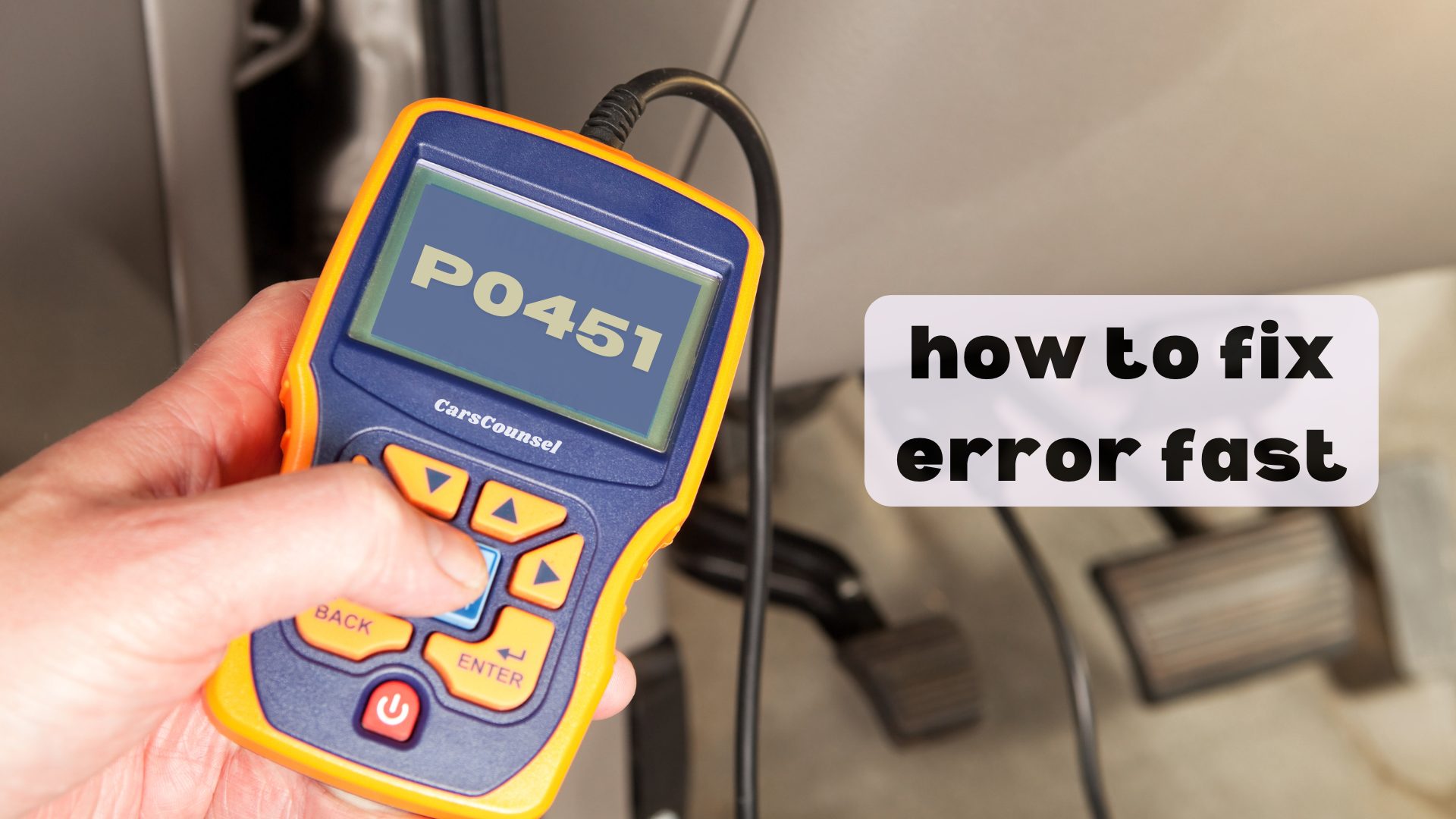It seems you’ve stumbled upon an unwelcome visitor – the check engine light on your dashboard. If you’ve received the P0451 code, it’s likely your fuel tank pressure sensor is acting up.
This sensor plays a pivotal role in monitoring pressure inside the fuel tank, which is essential for the evaporative emissions control system. But what exactly is going wrong, and how can you get your vehicle running smoothly again?

Quick Navigation
Key Takeaways
- The P0451 code indicates a problem with the fuel tank pressure sensor, which monitors pressure inside the fuel tank and is crucial for the evaporative emissions control system.
- A faulty fuel tank pressure sensor can cause issues with fuel leak detection, leading to further complications and affecting overall vehicle performance.
- The sensor’s accurate readings are vital, and inspecting sensor calibration methods is necessary to verify accurate readings and prevent fuel vapours from escaping into the atmosphere.
- Common causes of the P0451 code include a faulty fuel tank pressure sensor, wiring issues, problems with the evaporative emissions control system, vacuum leaks, and a fuel cap that is not properly sealed.
- Proper sensor maintenance and the resolution of evaporative emissions problems require replacing the faulty fuel tank pressure sensor with an OEM-quality part.
Understanding Code P0451
When your vehicle’s check engine light illuminates, it’s often a source of frustration and concern.
But, understanding what’s behind the error code can help you address the issue efficiently.
The P0451 code indicates a problem with the fuel tank pressure sensor, a pivotal component of the fuel system overview.
This sensor monitors pressure inside the fuel tank, which is essential for the evaporative emissions control system.
Sensor functionality is imperative, as it triggers the check engine light and stores the code in the vehicle’s computer system when a problem is detected.
Causes of Fuel Tank Pressure Issues
You’ve identified the P0451 code, which points to a problem with the fuel tank pressure sensor.
Now, it’s vital to determine the root cause of the issue. A faulty fuel tank pressure sensor is a common culprit, but it’s not the only one.
Wiring issues, evaporative emissions control system problems, vacuum leaks, and a fuel cap not properly sealed can also trigger the P0451 code.
Additionally, a malfunctioning sensor can affect fuel leak detection, leading to further complications.
It’s vital to inspect the sensor calibration methods to verify accurate readings.
Recognizing P0451 Code Symptoms
Your vehicle’s check engine light is illuminated, and you’re wondering what’s going on.
When the P0451 code is triggered, it’s essential to recognize the symptoms to address the issue promptly.
You may notice a decrease in fuel efficiency, which can be costly in the long run.
Additionally, your vehicle may stall or have difficulty starting, which can be inconvenient and frustrating.
Rough idling and emissions control system issues are also common symptoms of a faulty fuel tank pressure sensor.
Diagnosing and Repairing P0451
To pinpoint the root cause of the P0451 code, you’ll need to perform a thorough diagnosis, starting with a scan tool to read the code and confirm the sensor is faulty.
If the sensor is indeed faulty, inspect the wiring and connections to guarantee there are no loose or damaged components. Sensor failure can lead to fuel leaks, which can cause further damage to your vehicle’s emissions control system.
Check for any signs of fuel leaks or vacuum leaks, as these can also trigger the P0451 code. By methodically ruling out potential causes, you’ll be able to identify the underlying issue and take the necessary steps to verify it.
Replacing the Fuel Tank Sensor
Once the faulty fuel tank pressure sensor has been diagnosed, replacing it with a new, OEM-quality part is the next step.
This verifies proper sensor maintenance, which is vital for fuel efficiency and overall vehicle performance.
You’ll want to:
- Disconnect the electrical connector: Carefully remove the connector from the old sensor to prevent damage.
- Remove the sensor mounting bracket: Take out the screws or clips holding the sensor in place.
- Install the new sensor: Mount the new sensor securely and reconnect the electrical connector.
Remember to handle the new sensor with care to avoid damaging it.
After replacement, clear the P0451 code from your vehicle’s computer system and test drive to verify the issue is resolved.
Cost of Repairing P0451 Code
Replacing the fuel tank pressure sensor is just the first step in resolving the P0451 code issue; now you need to weigh the cost of repairing this problem. The cost of repair will depend on several factors, including the type of vehicle, labor rates, and the cost of replacement parts.
| Cost Factor | Estimated Cost |
|---|---|
| Sensor replacement | $50-$150 |
| Labor cost | $50-$150 |
| Diagnostic time | $20-$50 |
| Additional repairs | $50-$200 |
| Total estimated cost | $100-$300 |
Keep in mind that these estimates are approximate and may vary depending on your location and the specific needs of your vehicle. Additionally, resolving the P0451 code issue can also improve your vehicle’s fuel efficiency, making it a worthwhile investment in the long run.
Preventing Future Fuel Tank Issues
While driving, you’re likely unaware of the complex processes happening beneath the surface to keep your vehicle running smoothly.
One crucial aspect is the fuel tank pressure sensor’s role in maintaining a healthy evaporative emissions control system.
To prevent future fuel tank issues, follow these fuel maintenance tips and tank protection methods:
- Regularly inspect and maintain your fuel cap: Verify it’s properly sealed to prevent vacuum leaks and maintain ideal fuel tank pressure.
- Keep your fuel tank at least half full: This helps reduce condensation and prevents corrosion inside the tank.
- Avoid extreme temperatures and humidity: Park your vehicle in a shaded area or use a sunshade to prevent fuel evaporation and maintain a stable fuel tank environment.
Resolving Evaporative Emissions Problems
Two primary components of the evaporative emissions control system – the fuel tank pressure sensor and the purge valve – must work in harmony to prevent fuel vapors from escaping into the atmosphere.
When the fuel tank pressure sensor detects an issue, it triggers the check engine light and stores the P0451 code.
To resolve evaporative emissions problems, you’ll need to diagnose and repair the faulty sensor, wiring issues, or other components affecting the evaporative system.
Verify the fuel cap is properly sealed, and inspect the purge valve for blockages or malfunction.
More OBD-II Codes
Frequently Asked Questions
Can I Drive My Car With a P0451 Code?
You can drive your car with a P0451 code, but be cautious of fuel economy concerns and potential stalls or difficulty starting; take driving precautions, such as avoiding extreme temperatures and heavy loads, until the issue is resolved.
Will a P0451 Code Cause My Car to Fail Emissions Testing?
As you prepare for emissions testing, imagine a referee scrutinizing your car’s performance. Yes, a P0451 code can cause your car to fail, as it indicates a malfunction affecting emissions standards, triggering a red flag in testing protocols, and potentially leading to a failing grade.
Can a Faulty Oxygen Sensor Trigger a P0451 Code?
You’re wondering if a faulty oxygen sensor can trigger a P0451 code. The answer is no; the oxygen sensor isn’t related to fuel tank pressure sensor malfunction or fuel leak detection, so it won’t cause this specific code.
Are Fuel Tank Pressure Sensors Specific to Vehicle Makes?
Think of your vehicle’s fuel tank pressure sensor like a tailored suit – it’s designed to fit your ride’s unique needs. Yes, sensors are specific to vehicle makes, and compatibility varies due to differences in sensor technology and vehicle variations, requiring precise matching for peak performance.
Will a P0451 Code Reset Itself if the Problem Is Fixed?
You’ll need to clear the code manually, as it won’t reset itself, even if you fix the issue. After resolving the problem, such as fuel leakage or faulty sensor calibration, use a scan tool to delete the code and verify the sensor is functioning properly.
Conclusion
As you’ve navigated the nuances of the P0451 code, you’ve likely learned that faulty fuel tank pressure sensors can foster frustrating fuel system flaws. Fixing these flaws fast is vital to forestall further fuel-related fiascos. By following the diagnostic and repair steps outlined above, you’ll be well on your way to a worry-free driving experience, with a fuel system that’s functioning flawlessly and firing on all cylinders.

